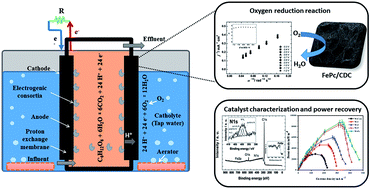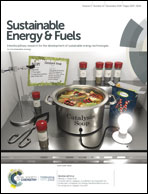Multi-walled carbon nanotube and carbide-derived carbon supported metal phthalocyanines as cathode catalysts for microbial fuel cell applications†
Abstract
Herein, iron phthalocyanine (FePc) and cobalt phthalocyanine (CoPc) were used to impregnate nitrogen and corresponding transition metals into the multi-walled carbon nanotubes (MWCNTs) or carbide-derived carbon (CDC) to compare the prepared highly efficient oxygen reduction reaction (ORR) catalysts for application in microbial fuel cells (MFCs). The results revealed that among all the catalysts investigated, FePc/MWCNT and FePc/CDC showed superior ORR activity, as determined by the rotating disk electrode (RDE) method under neutral pH. Moreover, the performance of MFC with FePc/CDC was comparable with that of MFC with Pt as a cathode catalyst in terms of power density (ca. 8.3 W m−3vs. 8.8 W m−3) and coulombic efficiency (16.9 ± 0.7% vs. 17.4 ± 0.7%). Hence, it can be concluded that FePc/CDC can be used as a low-cost alternative to expensive Pt-based cathode catalysts for the ORR in MFCs to make this technology effective for field scale applications.



 Please wait while we load your content...
Please wait while we load your content...